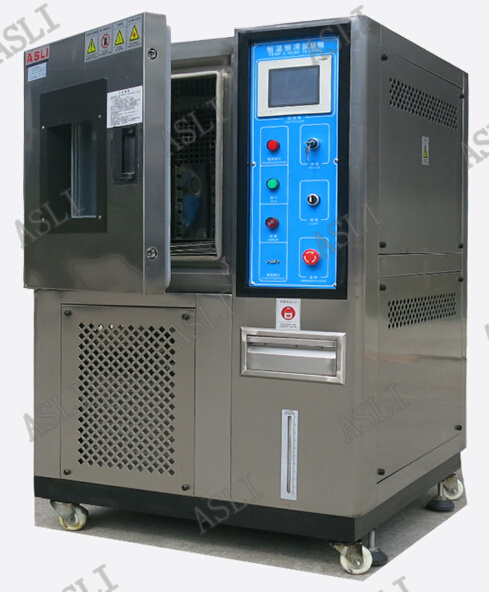For the daily use of the high-low temperature heat-humidity alternating current tester , some customers are not very skilled in use, resulting in some minor malfunctions in the occasional start-up operation of our equipment. The analysis is expected to be read carefully by our customers. 1. In the case of a power-hopping event, check the settings one by one. First set the machine to high temperature (40 degrees Celsius or 60 degrees Celsius), set the humidity to 0, and click Run to see if the machine will jump. If it is, it is a heating pipe. Short circuit, resulting in leakage, my driver will be protected will be the phenomenon of jump. If the heating tube is short-circuited, simply change the heating tube, which is very simple. 2. If the running high and low temperature humidity heat tester does not trip at high temperature, set the humidity and then continue to click Run to see if the machine trips. If it is tripped, the humidifying tube is short-circuited and leaks electricity. If this happens, simply unscrew the side bezel screws of the driver's device, remove the baffle, and you will see a humidifying bucket that pulls out the two wires above it and removes the 6 hexagonal cap screws on the cover. Remove, replace the humidification tube can be, when installed, the temperature probe needs to be bound on the humidification tube to prevent dry burning, over-temperature protection. In this way, we solved the small faults of the tripping of the high-low temperature wet-heat alternating current tester during startup. Most of these minor faults were improperly used by the customer in the previous period. In the absence of water, the humidity was running and the humidification tube continued to dry. When the over-temperature alarm is not issued, the life of the humidification tube is damaged, resulting in such a minor failure. Therefore, the customers are required to read the instructions carefully when operating the high-low temperature heat and humidity alternating test machine . Then, when the machine does not add pure water, and when the water is added, remember not to set the humidity so as to prevent the machine from alarming and damage the machine. Parts life. Oilseed Solvent Extraction Plant Solvent extraction is a process to extract the oil from oil bearing materials by means of a solvent. A typical solvent used is hexane, a by-product of petroleum. The solvent extraction plant is designed to extract oil directly from oil seeds containing less than 20% oil, like soybeans, after flaking. Or it extracts oils from pre-pressed or fully pressed cake of seeds containing more than 20% oil like sunflowers, peanuts, cotton seed, palm kernels, canola, copra, castor and a variety of other materials. Soybean Oil Solvent Extraction Turnkey Project,Palm Oil Solvent Extraction Turnkey Project,Sunflower Oil Solvent Extraction Turnkey Project,Plant Oil Solvent Extraction Turnkey Project Hebei Huipin Machinery Co.,LTD , https://www.oilpresschina.com
The purpose of solvent plant extraction is to remove most of the oil contained in the seed. Extraction is conducted on prepared seeds or, as generally occurs in the case of high oil content seeds, the cake obtained from pre-pressing. Solvent extraction consists of a sequence of five operations:
Preparation of seeds for extraction which includes pre-pressing for high oil content seeds.
Extraction of oil from the prepared material with the aid of a food-grade solvent.
Desolventising-toasting of the de-oiled seed/meal, often combined with drying and cooling of the said meal.
Distillation, to remove the solvent from the extracted oil.
Recovery of solvent, which is reused again and again at the extractor level.
Simple in structure with stable performance;
Additional horizontal grid plate prevents the miscella from flowing back into the material cell to ensure the best extraction effect;
The wet meal is discharged by the material discharger which continuously discharges the wet meal onto the wet meal conveyor. This avoids meal bridging, un-uniform wet meal discharging and extends the serviceable life of the wet meal conveyor.
Composed of pre-extraction, extraction and draining sections. There is material turnover in the process of extraction to make the extraction uniform and thorough. Special self-cell solvent spraying ensures the best effect during extraction.
Features of the Solvent Extraction Process
Evaporation takes place in a vacuum for the best oil quality.
Extraction system can process different raw materials.
Solvent recovery system from vent gas is particularly absorbent.
With full energy conservation and repeat utilization, steam consumption is markedly reduced.
Solvent Extraction Plants Supplied by Yongsheng
In order to meet different clients` requirements, we have a wide range of equipment with capacities from 300 kg to 100 metric tons. When refined, oil grades may qualify as Grade 1, Grade 2, Grade 3 or Grade 4. There are two technologies: one is batch, the other is continuous. Normally we adopt batch-type processing for capacities less than 20 t/d. Otherwise the process adopted is semi-continuous or continuous.
We continue to research new equipment. Yongsheng develops equipment designed to be fully automatic, utilizing advanced technology that can be combined according to different clients` requirements. The latest refining equipment consists of many single units and has a self-contained heating system which saves energy since it does not use a boiler. This equipment requires a smaller workspace and costs less. Furthermore, it has a wider range of functions and can be used to produce Grade 1, Grade 2, Grade 3 and Grade 4 oil.
Some minor faults in the operation of high-low temperature wet-heat alternating test machine